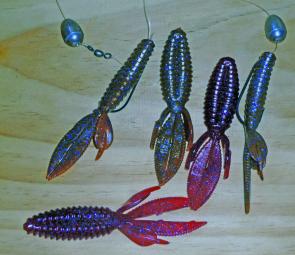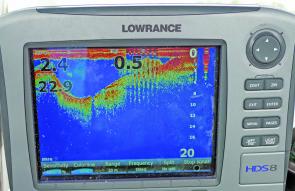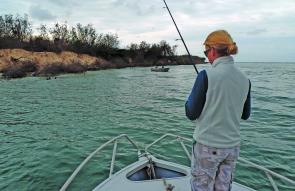Around 10 years ago I wrote an article for QFM about using soft plastics known as creature baits for flathead. Back then trolling for flathead with hardbodies was the go and the bream fishing juggernaut was in its infancy.
Most of the soft plastic brand names that you now see in the Aussie tackle shops were unknown even on the world market. The creature baits at the time were lizards and crawfish imitation soft plastics. They worked well when either Carolina or Texas rigged for flathead, but this was at a time when tackle stores still insisted that a flathead soft plastic must be either pink or green/yellow and have a curl-tail. Unfortunately for their popularity in Australia, the creature baits of the time tended to come in darker colours, like pumpkin (with chartreuse claws) or purple. These darker soft plastic lures did actually catch flathead, but didn’t catch the anglers.
The application behind the success of these soft plastics was that the lures floated or semi-floated. Rigging them on a trace a couple of feet long behind a running sinker meant that the lures could be dragged, floated or wafted beside fallen timber and through estuary weed beds; a prime flathead’s strike zone.
This technique is deadly when used to drag a soft plastic creature bait through or beside beds of short weed that had a few feet of water on them around the mud flats of the Jumpinpin. The rig is nothing more than the standard baitfishing and trace rig, except that the bait on the hook is replaced by a soft plastic lure. This is known as a Carolina rig.
I ventured out to chase flathead for a feed using the latest and most popular of the American creature baits down the Jumpinpin in late September this year. I also took along a copy of ‘Where You Can And Can’t Fish These Days’. I find it hard to remember all the Green Zones.
Previously I would have Carolina rigged a crawfish (soft plastic flat crawfish imitation) to catch a feed and I would have fished it around the shallow weed beds on a flooding tide. But this time I was keen to experiment.
The lure I was keen to try out was the Reaction Innovations Beaver. In the beginning, people grouped the Beaver in with the creature baits but now it has spawned its own style and genre. Its main advantage is that it has a wide body with respect to its length, which is ideal when you look at it from a flathead fishing point of view. Such a profile gives it a squid-like hover and waft when worked slowly around structure. The bulk of the lure also gives it great castability.
The Beavers can be fished straight out of the packet, like a squid, or you can pinch the joins with a fingernail to separate them and thus the legs (or claws) can waft about, which makes them look like a small brown/red crab. The beaver has a few arms that sort of wave around just a little bit, ever so subtly, just like a crab drifting with the current.
There are three sizes of the Beaver and seems two of them, the original Sweet Beaver 4.20 and the Double Wide Beaver, work the best as a wafting style for Aussie species. The Double Wide Beaver has a wider body that obviously accentuates the wafting attributes.
I was pretty confident of catching a feed if I used a Carolina rigged crawfish and dragged the lures through weeds in shallow water on a flooding tide on the flats around the mudflats. However, I was keen on fishing deeper water, and where there was a bit of current. For the deeper water (such as Kalinga bank) I wanted to try Texas rigging the Beaver with heavier egg weights up to 1/2oz.
Texas rigging is similar to Carolina, except that the sinker runs all the way to the hook. My version of the Texas rig has the fluorocarbon leader connected to braided main line and the sinker runs free on the leader that terminates at the worm hook on which the Beaver is rigged. This rig ensures that the sinker helps the lure’s castability and helps the lure to get down into the strike zone while allowing the lure to trail behind the sinker as the sinker falls through the water. When the sinker hits the bottom the lure hovers a few inches above the sea floor and stays visible to the flathead lying in wait. This also happens every time you hop the lure off the sea floor and then let the sinker fall back down to the bottom. It is a magic technique for ambush feeders and really works on Aussie flathead.
Originally greens and pinks were the most popular soft plastic colour for lizards. Then soft plastics became more popular with the Slider revolution at the start of this decade and pearl and/or variations, such as pearl with silver fleck, have since been strong sellers to flatty anglers. My recent tests with the Beavers included using browns and reds, to imitate crabs and squid, however, we caught a just under legal maximum flathead on a white Double Wide Beaver, which was the best fish of the outing. Any of these colours in creature baits wouldn’t seem out of place to the flathead.
Reads: 5427
Kim caught this Jumpinpin flathead on a Reaction Innovations Double Wide Beaver in white trash colouration.

A Carolina rigged and Texas rigged soft plastics; included are the top, side and splayed-leg/claw profiles of the Sweet Beaver (these are brown crab and red crab, there is also a molting crab colour).

Deep holes such as the one shown on the sounder are an ideal location in which to use the Texas presentation of a wafting soft plastic like the Sweet Beaver.

Fishing hard up against a steep bank with trees that have fallen into the water is the type of country where a presentation that is suited to wafting a lure slowly fluttering down to the strike zone is ideal. The free flow of line off a spin reel is an ad




